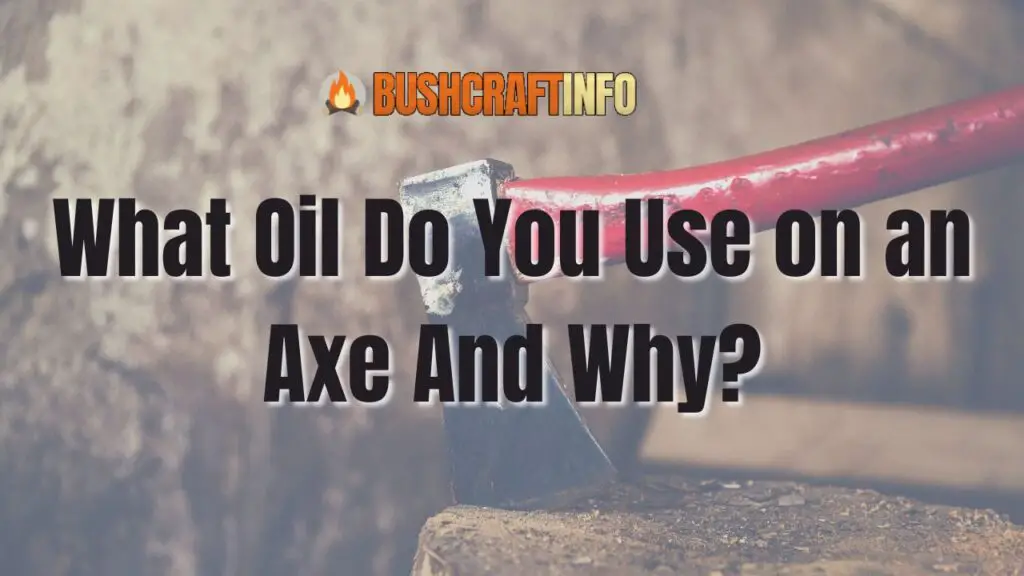Regular maintenance of your axe is one of the most important things you can do to keep it in good condition. This includes regularly oiling the head and handle. However, one of the most common questions that come to mind is what oil do you use on an axe and why do you use it?
Oils such as gun oil, Vaseline, and beeswax are commonly used on an axe for short-term storing while for prolonged storage, Cosmoline works best. The main purpose of using oil on an axe is to prevent it from rusting and to keep the metal in condition.
Having that said, there are a lot of things that you may not know already. After reading this article, you will not only learn about the most commonly used oils for axes but also learn why they are used.
If that sounds interesting enough to you, then keep on reading!

What Oil Do You Use on an Axe and Why?
As mentioned earlier, It is a common tradition that people use oil on their axes to keep them in a good condition. There are different types of oils available in the market and each one of them is used for a different purpose. The three most commonly used oils for an axe are gun oil, Vaseline, and beeswax. Let’s take a more detailed look at each one of them:
Gun oil: This is perhaps the most popular type of oil that is used on an axe. It is easily available and does a great job of preventing rust.
Vaseline: This is another popular option that is used for the same purpose as gun oil. It is also very effective in preventing rust.
Beeswax: This oil is not as commonly used as the other two but it is still a good option. It helps to keep the axe head conditioned and also prevents rust.
Cosmoline: This is not an oil that you would use on an axe regularly. It is mainly used for the long-term storage of axes. It does an excellent job of preventing rust and corrosion.
So, these are some of the most commonly used oils for an axe. Now, let’s take a look at why these oils are used. The main reason for using oil on an axe is to prevent it from rusting. Rust can cause damage to the axe head and make it difficult to use.
How Does Rust Form?
Rust is a type of corrosion that forms when iron or steel is exposed to oxygen and moisture. This can happen if you leave your axe out in the rain or if it gets wet for any other reason. When the metal comes into contact with water, it starts to oxidize.
This creates an electrolyte that causes a chemical reaction with iron or steel. This reaction causes the metal to break down and form rust. This might sound a bit nerdy, but this is the easiest explanation for the process of rusting.
Once the rusting process begins, the infected metal starts losing its properties, and as a result, it will no longer be as useful as it used to be. This is why it is important to prevent rust from forming in the first place, and this is also where oil comes in.
When you oil your axe, you are creating a barrier between the metal and the environment. This barrier prevents oxygen and moisture from coming into contact with the metal, and as a result, it prevents rust from forming.
Can you Use Any Type of Oil on an Axe?
Ok so far, you’ve learned that you can use oil to prevent an axe from rusting. However, a question you might have is “Can you use any type of oil on an axe?”
The answer to this question is no, you cannot use just any type of oil on an axe. The reason for this is that some oils can damage the metal on an axe. So, what kind of oil should you use then? The best oil to use on an axe is light mineral oil.
This type of oil will help protect the metal without damaging it. You can find this oil at most hardware stores.
Is it Must to Oil an Axe?
The next question that you may have on your mind is whether it is necessary to oil your axe or not. The answer to this question is yes, and I highly recommend oiling your axes regularly. This will help keep it in excellent condition for a longer period.
Besides that, it will also prevent the rusting process of the metallic axe head. If you live in a humid climate, then it is even more important to oil your axe regularly. The best way to oil an axe is to first clean the head and handle with a cloth.
Once it is clean, apply a thin layer of oil to the head and handle. You can use a brush or your fingers to apply the oil. Wipe off any excess oil and store the axe in a cool and dry place. I would recommend doing this at least once a month to keep your axe in good condition.
Do You Need to Oil the Handle of the Axe Too?
The answer to this question is yes, you will need to oil the handle of the axe too just like you oil the head of your axe. You might be wondering why should I oil the handle now? Just because it isn’t made of metal doesn’t mean it won’t get damaged with time.
Most of the time, the handle of the axe gets dried which causes cracking, and hence, it becomes difficult to use the axe. Therefore, it is always better to oil the handle so that it doesn’t get damaged easily and lasts longer.
Another reason why people oil the handle of the axe is to prevent the handle from absorbing too much humidity. When the handle absorbs too much humidity, it can become weak and can break easily. If you live in an area with a lot of humidity, then it is highly recommended that you oil the handle of your axe regularly.
What is the Best Oil for an Axe
Another common question that most people may have on their minds is what is the best oil for an axe. I understand selecting the right oil for your axe can be difficult, but you shouldn’t worry because I’ve already covered you.
I’ve listed some of the best oils for an axe that is easy to get, affordable and reliable for prolonged usage, and will keep your axe in the best condition for a long time. So, without further ado, let’s get started.
1. 100% Pure Tung Oil
Pure Tung oil is something that you can easily find and is quite affordable as well. It is made from the seeds of the Tung tree and has been used for centuries to protect metal tools from rusting. When applied to an axe, it will create a waterproof barrier that will prevent moisture and oxygen from coming into contact with the metal and will prevent rust from forming.
2. Mineral oil
Mineral oil is another great option that you can use to protect your axe from rusting. It is a light oil that will not damage the metal on your axe and will provide a good amount of protection against moisture and oxygen. You can find this oil at most hardware stores as well as on amazon.
3. Linseed oil
Linseed oil is made from flax seeds and has been used for centuries to protect metal tools from rusting. When applied to an axe, it will create a waterproof barrier that will prevent moisture and oxygen from coming into contact with the metal and will prevent rust from forming.
4. Walnut oil
Walnut oil is mostly used to cover the handles of the axe to prevent them from drying out and cracking. However, it can also be used to protect the metal on your axe from rusting. Walnut oil is a natural oil that will not damage the metal on your axe and will provide a good amount of protection against moisture and oxygen.
5. Beeswax
Last but not least, beeswax is something a bit different than the other oils on this list, but it can be used to protect your axe from rusting. Beeswax is a natural wax that is widely used to protect the tool’s handles from cracking when storing tools. However, it is not used commonly when storing the tools for a longer duration. But when it comes to shorter storage time, the beeswax works like a charm. Furthermore, you can easily get it and apply it to your axe without any issue at all.
How Often Should You Oil Your Axe Head
A lot of beginners might be confused when it comes to oiling their wax. They might not know how often they should do it. The answer to this question is:
It depends. If you use your axe a lot, then you won’t need to oil it more often. However, if you only use it occasionally, then you can oil it frequently. The main purpose of oiling your axe head is to protect it from rust.
Rust can occur when the metal on your axe head comes into contact with oxygen as mentioned above. Oiling the head of your axe will easily cover it and prevent the oxidation reaction thus prolonging the overall lifespan of the axe.
I highly recommend oiling your axe head at least once a month when not using it. However, you should also avoid using excessive oil as it will only attract dirt and dust, which can also lead to rusting.
Too much oil can also make your axe head slippery, which is dangerous. The best way to oil your axe head is to use a clean cloth. Simply dip the cloth in some oil and then rub it on the surface of the axe head. Wipe off any excess oil with a clean cloth.
When Should I Oil My Axe Handle?
I’ve already mentioned, that oiling your axe handle is as important as the head of your axe. The handle is constantly exposed to the elements and can easily get damaged if not properly cared for. Oiling your axe handle will protect it from water damage as well as prevent it from cracking.
I recommend oiling your axe handle at least once a week, but you can do it more often if you want. Again, make sure to use a clean cloth and wipe off any excess oil.
Things to Keep in Mind While Choosing the Right Oil for an Axe
We’ve discussed a lot of important things, but there are a few more things you should keep in mind while choosing an oil for your axe. Keeping these points in your mind will help narrow down your search space and allow you to choose the best oil for your axe in no time.
Moreover, it will also help you choose the right oil for your axe every single time without doing a lot of digging. So with that said, let’s take a look at some of the most important factors to keep in mind while choosing oil for your axe.
Type of Oil
The first and the most important thing to keep in mind is what type of oil to use. There are different types of oils available in the market and each one has its own unique benefits. Some of the most popular oils include mineral oil, olive oil, flaxseed oil, etc.
Each one of these oils has its own set of advantages and disadvantages. Therefore, it is important to choose an oil that best suits your needs. For instance, if you are looking for an oil that can protect your axe from rust, then you should go for mineral oil.
On the other hand, if you are looking for an oil that can help in maintaining the Axe’s edge, then you should go for flaxseed oil. It is also important to note that different oils have different shelf lives. For instance, mineral oil has a longer shelf life as compared to flaxseed oil.
Therefore, it is important to choose an oil that best suits your needs and requirements.
Viscosity
The viscosity of an oil is measured in terms of its thickness. The thicker the oil, the higher its viscosity. For instance, olive oil has a higher viscosity as compared to mineral oil.
The advantage of using a high viscous oil is that it can provide better protection to your axe. However, the downside is that it can make your axe feel heavy and can also increase the friction while using it.
Therefore, it is important to choose an oil that has the right viscosity for your needs. If you are looking for an oil that can provide better protection, then you should go for a high viscous oil. On the other hand, if you are looking for an oil that can help in reducing friction, then you should go for low viscous oil.
Drying Time
The drying time of an oil is the amount of time it takes for the oil to dry off after it has been applied. The advantage of using an oil with a shorter drying time is that it can help in reducing the downtime while using your axe.
On the other hand, the disadvantage of using an oil with a shorter drying time is that it can increase the chance of the oil getting wiped off while using your axe. Therefore, it is important to choose an oil that has the right drying time for your needs.
If you are looking for an oil that can help reduce downtime, then you should go for an oil with a shorter drying time. On the other hand, if you are looking for an oil that can provide better protection, then you should go for an oil with a longer drying time.
Types of Additives
Another important factor to consider is the type of additives present in the oil. The type of additives present in oil can have a significant impact on its performance. Some of the most common additives include anti-rust agents, friction reducers, etc.
Therefore, it is important to choose an oil that has the right type of additives for your needs. If you are looking for an oil that can provide better protection against rust, then you should go for oil with anti-rust agents.
On the other hand, if you are looking for an oil that can help reduce friction while using your axe, then you should go for oil with friction reducers.
Final Words
If you’ve made it this far, you must have got an answer to your question i.e. what oil do you use on an axe and why? To conclude the above information quickly, there are various types of oils used for oiling the head and the handle of the axe including beeswax, Vaseline, gun oil, and cosmoline.
Oiling an axe is important as it helps to prevent the head of an axe from rusting by preventing the oxidation reaction. In addition, it also helps in protecting the handle of the axe from drying and cracking or losing its properties by absorbing an excessive amount of moisture.
I hope, you’ve enjoyed reading this article, please don’t forget to share it with your friends and family too!
Thanks for reading!
Was this post helpful?

Hey I’m Josh! I have been practicing Bushcraft for a little over 6 years now! I Started this website to review awesome bushcraft gear that I love as well as share information I have learned along the way!


